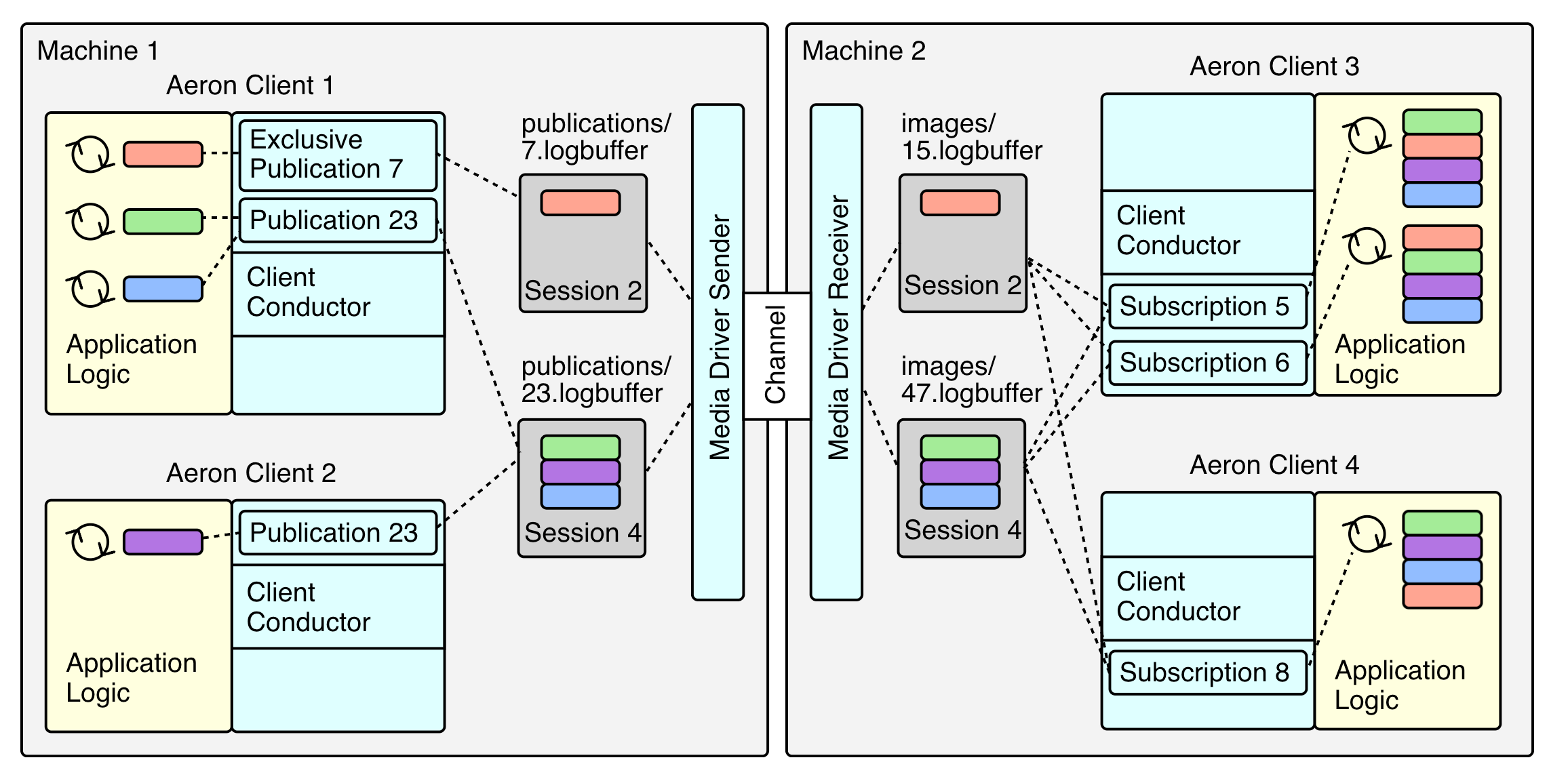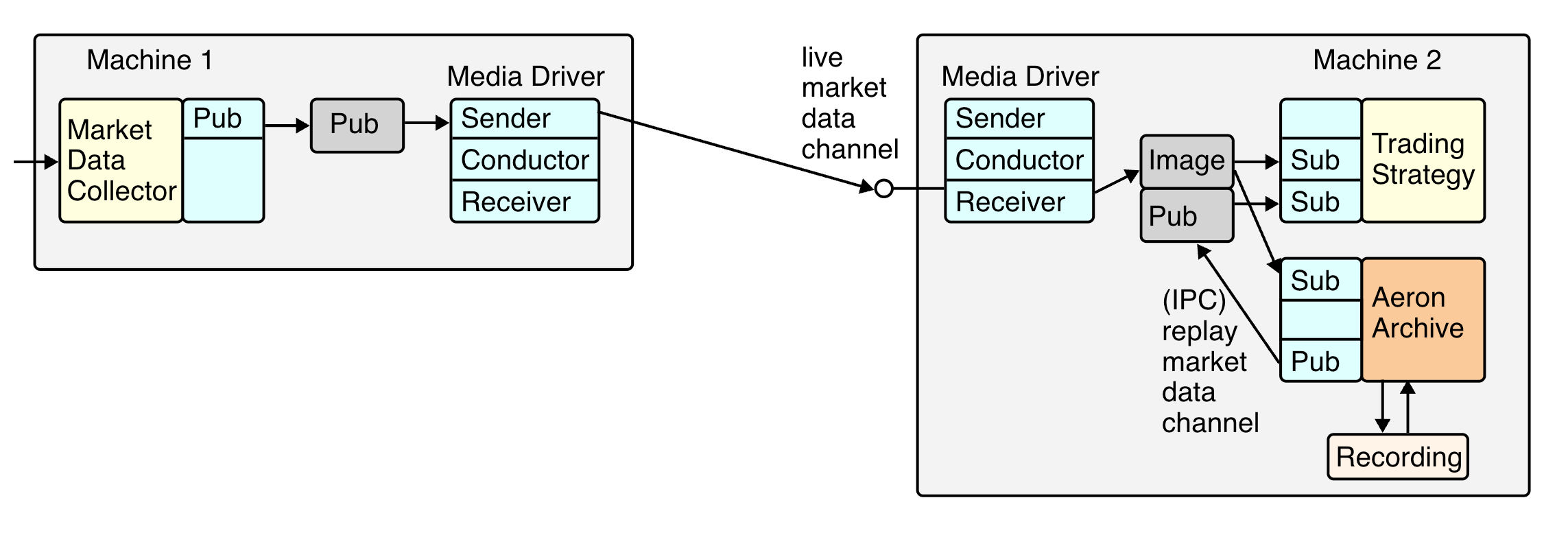Aeron is an efficient reliable UDP unicast, UDP multicast, and IPC message transport.
why using aeron cluster
key advantages:
- ultra-low latency & high throughput (UDP/IPC)
- zero-copy architecture (tryClaim with shared memory)
- integrated stack benefits (transport, archive, cluster)
comparing with other popular architectures
graph LR
subgraph "Message Transport Layer"
A[Aeron UDP/IPC]
K[Kafka TCP]
R[RabbitMQ AMQP]
P[Pulsar TCP]
end
subgraph "Consensus Layer"
AC[Aeron Cluster Raft]
kr[KRaft]
ZK[ZooKeeper ZAB]
E[etcd Raft]
C[Consul Raft]
end
subgraph "Persistence Layer"
AA[Aeron Archive]
KL[Kafka Log Segments]
RL[RabbitMQ Disk Store]
PL[Pulsar BookKeeper]
end
A --> AC --> AA
K --> kr --> KL
R --> ZK --> RL
P --> E --> PL
the authentic basic rule in aeron
Agent which follows Actor Model and Single-Threaded event loop.
correlationId is critical, too; the agent simply knows how to doWork, but doesn’t know what’s the data for.
- MediaDriver – DriverConductor
- ArchivingMediaDriver – ArchiveConductor
- ConsensueModule – ConsensueModuleAgent, ClusteredServiceAgent
how to communicate – transport
A design goal for Aeron is to be the highest throughput with the lowest and most predictable latency of any messaging system.
UDP is used when the processes are on different machines. IPC is used when they’re on the same machine.
to me, aeron transport was some kind of TCP built upon UDP.
overview
this is how the publication from machine-1 gets subscribed by machine-2 with multiple publications & multiple subscriptions. You can check the full walk through at theaeronfiles.
- exclusivePublication only one publication instance (session)
- shareablePublication can be held by multiple publication instances
- a publication could be subcribed multiple times
- read data from the same image log-buffer

|
|
MediaDriver
By default, Aeron Transport creates files below the /dev/shm directory on Linux systems. aka SharedMemory.
cnc.datstores control and response for client-conductor and media driver conductor; also other interal states (counters, positions)loss-report.datany message loss for Network Publicationsimageson receiver side, log bufferpublicationson sender side, log buffer
|
|
persistency – archive
Aeron Archive builds on top of Aeron Transport - it allows the streams of messages sent through Aeron to be captured and recorded to disk, so they can be replayed later.
overview
Archive on the subscription side, spy data from image logbuffer for recording, also a demostration of replay data from Archive.
lets take machine-1 as 10.110.0.1, and machine-2 as 10.110.0.2
|
|

aeron archive file structure.
- {recordingId}-{segmentFileBasePosition}.rec
- All the Segment files for a particular Recording have the same fixed length. The length must be a power of 2 between 64 KB and 1 GB inclusive and must hold at least one Term from the Publication being recorded (the default length is 128 MB).
- recordingId was maintained inside
Archive,Catalog#addNewRecording
- archive.catalog
- contains a series of RecordingDescriptor records
- aeron-archive-codecs.xml
- archive-mark.dat
- to guard the archive directory so that only one instance of Aeron Archive can use it at a time
|
|
control flow
sequenceDiagram
participant CA as Client Application
participant AAC as AeronArchive Client
participant AP as ArchiveProxy
participant AS as Active Service (ArchiveConductor)
participant RS as RecordingSession
participant SF as Segment Files
CA->>AAC: connect()
AAC->>AP: connectResponseChannel, streamId
AP->>AS: ConnectRequest
AS-->>AP: ControlResponse(OK)
CA->>AAC: startRecording(channel, streamId)
AAC->>AP: startRecording(channel, streamId)
AP->>AS: StartRecordingRequest
AS->>RS: create
RS->>SF: write(data)
AS-->>AP: ControlResponse(OK, subscriptionId)
CA->>AAC: replay(recordingId, position, length)
AAC->>AP: replay(recordingId, position, length)
AP->>AS: ReplayRequest
AS-->>AP: ControlResponse(OK, replaySessionId)
CA->>AAC: stopRecording(subscriptionId)
AAC->>AP: stopRecording(subscriptionId)
AP->>AS: StopRecordingRequest
AS->>RS: abort
AS-->>AP: ControlResponse(OK)
ArchivingMediaDriver
- the media driver in Archive
- archive –
ArchiveConductor- recorder
RecordingSession
- replayer
ReplaySession
- sessionWorker
Session
- recorder
- catalog – keeps details of recorded images, past and present, and used for browsing
|
|
consensus – cluster
Aeron Cluster provides an implementation of Raft Consensus upon which highly available services can be built.
Aeron Cluster has the following capabilities:
- sequences multiple client connections into a single, replicated log
- provides efficient fault tolerance with 2 or more nodes (raft definition)
- provides Aeron Archive endpoints for writing to snapshots and reading from snapshots on start (clean and restore)
- allows 1 or more clustered services to be run, with support for inter-service sequenced messaging reliable, sequenced timers
- very high levels of performance, in particular with premium features such as kernel bypass when using the C media driver
overview
sequence of how the client-side data was proceeded in aeron-cluster.
sequenceDiagram
participant Client
participant Leader
participant Follower1
participant Follower2
participant Service
Client->>Leader: offer(message)
Leader->>Leader: onIngressMessage()
Leader->>Leader: Append to log (LogPublisher)
Leader->>Follower1: Replicate log entry
Leader->>Follower2: Replicate log entry
Follower1->>Follower1: Append to log
Follower2->>Follower2: Append to log
Leader->>Service: Deliver message (ClusteredService)
Service->>Leader: Process and respond (no exception)
Leader->>Client: Send response (pollEgress)
aeron cluster consensus module file structure.
- cluster-mark.dat – essential metadata,
ClusterToolreads- cluster id
- member id
- appointed leader id
- log position – current position in the consensus log
- timestamp – when the mark file was last updated
- possible leader timeout
- cluster members information
- node-state.dat
- An extensible list of information relating to a specific cluster node.
- Raft-related State:
- The current term
- The votedFor member ID for the current term
- Information about the log position and leadership term ID for the last committed entry.
- Recovery Pointers: Pointers to the latest snapshot and the position in the replicated log where recovery should start from if the node restarts.
- Raft-related State:
- An extensible list of information relating to a specific cluster node.
- recording.log
- a sequence of log entries that represent the complete history of the cluster’s state machine
- it acts as a metadata catalog for the Aeron Archive, saying it contains termId-recordingId which points to
0-{offset}.recfiles
|
|
ClusteredMediaDriver
- the media driver
- archive (persistency)
ArchiveConductor - consensusModule (raft implementation), the core
ConsensusModuleAgent - consensusModule communicates with service,
ClusteredServiceAgent
|
|
ConsensusModuleAgent
graph LR
CMA["ConsensusModuleAgent<br/>(ConsensusModuleAgent.java)"]
%% Core Raft State
CMA --> |"role, state, term"| RS["RaftState<br/>role: Cluster.Role<br/>state: ConsensusModule.State<br/>leadershipTermId: long<br/>logPosition: long"]
%% Election & Leadership
CMA --> |"election"| EL["Election<br/>consensusModuleId: int<br/>leaderMember: ClusterMember<br/>candidateTermId: long<br/>isLeaderStartup: boolean"]
%% Log Replication
CMA --> |"logReplication"| LR["LogReplication<br/>logPublisher: LogPublisher<br/>appendPosition: long<br/>followerCommitPosition: long<br/>replicationSessionId: long"]
%% Ingress/Egress
CMA --> |"ingressAdapter"| CIA["ClusterIngressAdapter<br/>fragmentHandler: IngressFragmentHandler<br/>subscription: Subscription"]
CMA --> |"egressPublisher"| CEP["EgressPublisher<br/>publication: ExclusivePublication<br/>sessionId: long<br/>streamId: int"]
%% Service Adapter
CMA --> |"serviceAdapter"| SA["ServiceAdapter<br/>serviceControlPublisher: ServiceControlPublisher<br/>serviceControlSubscription: Subscription<br/>consensusModuleProxy: ConsensusModuleProxy"]
%% Archive Integration
CMA --> |"logPublisher"| LP["LogPublisher<br/>publication: ExclusivePublication<br/>maxPayloadLength: int<br/>sessionId: long"]
CMA --> |"logAdapter"| LA["LogAdapter<br/>subscription: Subscription<br/>fragmentHandler: FragmentHandler<br/>image: Image"]
%% Timer Management
CMA --> |"timerService"| TS["TimerService<br/>wheel: TimerWheel<br/>timeUnit: TimeUnit<br/>resolution: long"]
%% Session Management
CMA --> |"sessionByIdMap"| SBM["Int2ObjectHashMap<ClusterSession><br/>ClusterSession.state<br/>ClusterSession.lastCorrelationId<br/>ClusterSession.timeOfLastActivityNs"]
%% Pending Service Messages
CMA --> |"pendingServiceMessages"| PSM["ArrayDeque<ServiceMessage><br/>ServiceMessage.buffer<br/>ServiceMessage.offset<br/>ServiceMessage.length"]
%% Cluster Members
CMA --> |"clusterMembers"| CM["ClusterMember[]<br/>ClusterMember.id<br/>ClusterMember.clientFacingEndpoint<br/>ClusterMember.memberFacingEndpoint<br/>ClusterMember.logEndpoint<br/>ClusterMember.transferEndpoint<br/>ClusterMember.archiveEndpoint"]
%% Timers & Timeouts
CMA --> |"timeouts"| TO["Timeouts<br/>electionTimeoutNs: long<br/>heartbeatTimeoutNs: long<br/>heartbeatIntervalNs: long<br/>leaderHeartbeatIntervalNs: long"]
%% Archive Context
CMA --> |"archiveCtx"| AC["AeronArchive.Context<br/>controlRequestChannel: String<br/>controlRequestStreamId: int<br/>controlResponseChannel: String<br/>controlResponseStreamId: int<br/>recordingEventsChannel: String"]
%% Cluster Context
CMA --> |"ctx"| CC["ConsensusModule.Context<br/>clusterId: int<br/>serviceCount: int<br/>appointedLeaderId: int<br/>memberEndpoints: String<br/>clusterDir: File<br/>archiveContext: AeronArchive.Context<br/>deleteDirOnStart: boolean"]
%% Mark File
CMA --> |"markFile"| MF["ClusterMarkFile<br/>markFileDir: File<br/>clusterId: int<br/>memberId: int<br/>appointedLeaderId: int<br/>serviceId: int<br/>joinPosition: long"]
%% Aeron Instance
CMA --> |"aeron"| AER["Aeron<br/>context: Aeron.Context<br/>clientLock: ReentrantLock<br/>isClientConductorFromDriver: boolean"]
%% Sequence Numbers & Positions
RS --> |"maintains"| SEQ["Sequence Tracking<br/>expectedAckPosition: long<br/>serviceAckId: long<br/>terminationPosition: long<br/>logServiceSessionId: long<br/>logSubscriptionId: long"]
%% Election State
EL --> |"tracks"| ES["Election State<br/>nominations: Int2IntCounterMap<br/>thisMemberPosition: long<br/>appendPosition: long<br/>catchupPosition: long"]
%% Log Replication Details
LR --> |"manages"| LRD["Replication Details<br/>nextIndex: long[]<br/>matchIndex: long[]<br/>timeOfLastAppendPositionNs: long<br/>timeOfLastUpdateNs: long"]
%% Service Control
SA --> |"controls"| SC["Service Control<br/>ackId: long<br/>serviceId: int<br/>logPosition: long<br/>leadershipTermId: long<br/>timestampNs: long"]
%% Timer Wheel
TS --> |"uses"| TW["TimerWheel<br/>currentTick: long<br/>resolution: long<br/>wheel: TimerWheel.Timer[]<br/>timersPerWheel: int"]
%% Session State
SBM --> |"contains"| SS["Session State<br/>id: long<br/>responseStreamId: int<br/>responseChannel: String<br/>encodedPrincipal: byte[]<br/>timeOfLastActivityNs: long<br/>correlationId: long"]
%% Member State
CM --> |"tracks"| MS["Member State<br/>id: int<br/>clientFacingEndpoint: String<br/>memberFacingEndpoint: String<br/>logEndpoint: String<br/>transferEndpoint: String<br/>archiveEndpoint: String<br/>isLeader: boolean"]
%% Styling
classDef agent fill:#e1f5fe,stroke:#01579b,stroke-width:3px
classDef raft fill:#f3e5f5,stroke:#4a148c
classDef communication fill:#e8f5e8,stroke:#1b5e20
classDef storage fill:#fff3e0,stroke:#e65100
classDef session fill:#fce4ec,stroke:#880e4f
classDef timer fill:#f1f8e9,stroke:#33691e
classDef context fill:#f9fbe7,stroke:#827717
class CMA agent
class RS,EL,LR,ES,LRD raft
class CIA,CEP,SA,SC communication
class LP,LA,AC,MF storage
class SBM,PSM,SS session
class TS,TO,TW timer
class CC,CM,MS,AER,SEQ context
how to debug & solve problems
official tools
media driver
- AeronStat
- ErrorStat
- StreamStat
- LossStat
Archive & Cluster
- ArchiveTool
- describe
- dump
- errors
- pid
- ClusterTool
- list-members
- recording-log
- snapshot
- describe
|
|
what if the last update timestamp in cluster-mark.dat is far away
immediate consequences
- stale leadership
- (possible) log position drift
recovery challenges
- extended catch-up period
- snapshot requirements
- maybe a full snapshot if the log gap is too large
- snapshots are expensive operations that impact cluster performance
- may trigger automatic snapshot creation on other nodes
cluster health impact
- election disruption
- node may vote based on outdated information
- could delay or complicate election
- may cast votes for candidates that are no longer viable
- network partition detection issues
